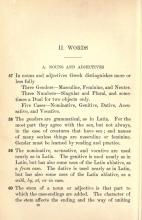57. In nouns and adjectives Greek distinguishes more or less fully:
Three Genders: Masculine, Feminine, and Neuter.
Three Numbers: Singular and Plural, and sometimes a Dual for two objects
only.
Five Cases: Nominative, Genitive, Dative, Accusative, and Vocative.
58. The genders are grammatical, as in Latin. For the most part they agree with the sex, but not always, in the case of creatures that have sex; and names οf many sexless things are masculine or feminine. Gender must be learned by reading and practice.
59. The nominative, accusative, and vocative are used nearly as in Latin. The genitive is used nearly as in Latin, but has also some uses of the Latin ablative, as a from case. The dative is used nearly as in Latin, but has also some uses of the Latin ablative, as a with, by, at, or in case.
60. The stem of a noun or adjective is that part to which the case-endings are added. The character of the stem affects the ending and the way of uniting one to the other. Nouns and adjectives are declined in three ways, named from the last letter of the stem:
The Ο-Declension, for stems in -o
The A-Declension, for stems in -ᾱ;
The Consonant Declension, for stems that end in a consonant or in ι or υ.
The Ο- and A-Declensions are so much alike that they are together called the Vowel Declension.
61. The article ὁ, ἡ, τό (the), may be used with any noun, and is a convenient mark of gender.
a. The article has no vocative. The interjection ὦ (O) is familiarly used with a vocative noun, without the emotional tone which O implies in English.



